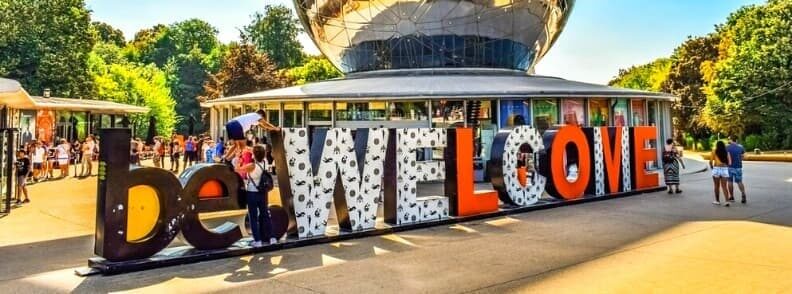When you visit Brussels Belgium, you’re stepping into a city where the past meets the future in a way that feels both effortless and magnetic. Right away, you’ll notice this isn’t just any European capital. It’s the beating heart of the European Union, with modern glass buildings of the EU headquarters sharing space with centuries-old Gothic and Baroque architecture. It’s an unusual but compelling mix that only Brussels can pull off, and you’ll see it in the way the cobbled medieval streets twist and turn around sleek, contemporary structures. For any Brussels travel guide, these contrasts are what keep visitors intrigued and locals constantly rediscovering their city.
There’s a reason Brussels is often referred to as the capital of Europe, beyond just the politics. This is a city where international influences are unavoidable. The presence of the European Parliament and NATO brings in a wave of global flavors, languages, and events that shape daily life. From my own experience, visiting Brussels Belgium feels like getting a taste of many cultures in one place. You might find yourself hearing French, Flemish, and English all within a few minutes’ walk, especially as you pass vibrant neighborhoods like Saint-Gilles or the European Quarter.
The city is also steeped in a rich blend of French and Flemish culture. What’s interesting here is how it’s woven into everyday experiences. You’ll sip strong Belgian coffee while passing ornate Art Nouveau façades, or indulge in a plate of moules-frites (with a side of perfectly crisped frites, of course) before heading into a gallery to see works by Magritte. It’s a place where you won’t just see contrasts — you’ll taste them. For food lovers, dining at places like Frites Atelier Bruxelles is a must, and yes, the hype around Belgian fries is well-deserved. It’s all part of the local identity that makes every visit memorable.
But Brussels isn’t all business and old-world charm. There’s a lively spirit that comes alive as you explore more. By day, you’ll wander through places like the Grand Place, bustling markets, or green spaces like Bois de la Cambre. As the sun sets, the city’s nightlife comes into focus. Trendy cocktail bars, traditional beer cafes, and clubs like Fuse transform the evening into a new adventure. Whether it’s meeting locals over a pint of lambic at a centuries-old tavern or catching live music in the Marolles district, Brussels knows how to keep things interesting, and it’s this side of the city that surprises most first-timers.
I’ve been back to Brussels many times, and what stands out is that you don’t need to dig deep to find something fascinating. The mix of places to visit in Brussels keeps me coming back, and I’m sure it’ll keep you captivated too. This isn’t a city that tries too hard to impress; instead, it effortlessly draws you in with its layers of history and culture, presented in a way that feels refreshingly genuine. So, whether you’re here for the waffles, museums, or politics, or just to explore with a Brussels visit card in hand, there’s always something new to experience.
Disclosure: Some of the links below are affiliate links. This means that at no extra cost to you, The Travel Bunny will earn a small commission if you click through and make a purchase. Thank you!
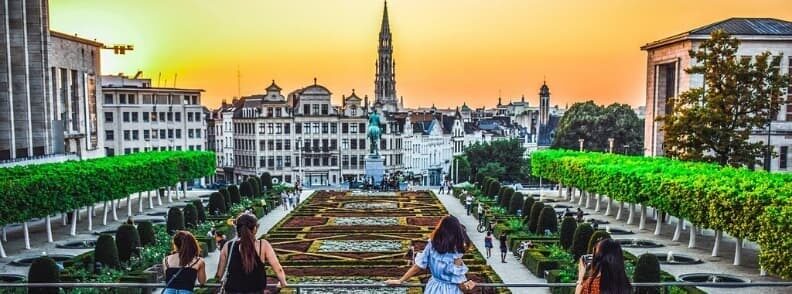
Top Must-See Attractions in Brussels
When you visit Brussels, you’re stepping into a city where grand history and playful art coexist around every corner. This Brussels city guide is your perfect companion to uncover the must-see spots that will leave you in awe. From architectural gems to quirky landmarks, here’s what to visit in Brussels.
An Absolute Must: The Grand Place and the Neighbouring Galleries
The Grand Place is more than just a square; it’s the dazzling, beating heart of Brussels and a UNESCO World Heritage Site. The 15th-century Town Hall towers over the square with its intricate Gothic design, while the gilded Guild Houses display their grandeur in every detail. The best times to visit? August, when the Flower Carpet blankets the square in a sea of blooms, or December, when the Winter Wonders Christmas market brings a festive, magical atmosphere.
Just around the corner, the Royal Saint-Hubert Galleries await. These glass-roofed arcades, Europe’s oldest shopping galleries, offer a mix of luxury shops, cozy cafés, and artisan chocolate stores. Indulge in some retail therapy or grab a sweet treat, and soak in the timeless elegance of this historic space.
Manneken Pis: It’s Not the Size That Matters
Just a short walk from the Grand Place, you’ll find Brussels’ cheeky mascot, Manneken Pis. Sure, he’s small, but his mischievous spirit is legendary. There are countless stories about why this little statue is so important to the city, and over the years, he’s become an icon of humor and resilience. What makes him even more fun is his ever-changing wardrobe. Head to the nearby GardeRobe Museum to marvel at over 1,000 costumes, from national dresses to themed outfits donated by visiting dignitaries. Whether you find him amusing or a bit overrated, seeing Manneken Pis is a rite of passage when you’re visiting Brussels.
When Size Does Matter: The Palace of Justice
Towering over the city, the Palace of Justice is a colossal building with a complex history. It’s one of the largest courthouses in the world and has been under renovation for decades. Despite the scaffolding, the building’s imposing presence is undeniable, and the panoramic views from here are stunning. It’s perched right above the Marolles District, so you can easily explore both in one visit.
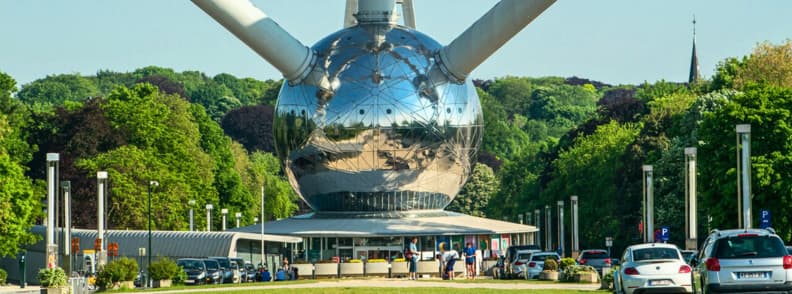
The Atomium: The Landmark
Prepare to be wowed by the Atomium, a futuristic marvel built for the 1958 World Fair. Standing 102 meters tall, this structure represents an iron atom magnified 165 billion times. Each of its nine spheres offers something unique, from exhibitions on science and design to immersive light shows. The top sphere boasts 360-degree panoramic views of the city, perfect for snapping that postcard-worthy photo. After exploring the Atomium, families should make their way to Mini-Europe next door. It’s a whimsical attraction where you can see detailed models of Europe’s most famous landmarks, from the Eiffel Tower to the Leaning Tower of Pisa. A visit here is like a mini adventure across the continent.
Comic Strips in the Streets: The Comic Strip Trail
For a fun, interactive way to explore Brussels, follow the Comic Strip Trail. This city is the capital of comic books, and you’ll find over 80 larger-than-life murals celebrating famous Belgian characters like Tintin, Lucky Luke, and The Smurfs. It’s an engaging activity for all ages, making the city feel like an open-air gallery. Start your journey at the Belgium Comic Strip Center, located in a beautiful Art Nouveau building designed by Victor Horta. Here, you’ll get a crash course on the history of Belgian comics and see original drawings from your favorite stories. Walking the trail feels like a playful treasure hunt, perfect for photo ops and discovering hidden corners of Brussels.
Culture with a View: The Mont des Arts
Perched between the upper and lower towns, Mont des Arts is a cultural and visual highlight of any Brussels visit. The beautifully landscaped gardens offer one of the best views of the city, especially as the sun sets behind the skyline. This area is a cultural goldmine, home to institutions like BOZAR, a hub for contemporary art and performances, and the Magritte Museum, dedicated to the surrealist works of René Magritte. Even if museums aren’t your thing, the atmosphere at Mont des Arts will inspire you. It’s the perfect spot to pause, take in the scenery, and maybe even snap a photo or two.
Spotlight on the Masters: The Royal Museums of Fine Arts
Art enthusiasts, this one’s for you! The Royal Museums of Fine Arts is a complex of six museums housing everything from classical to contemporary art. Highlights include works by Flemish Masters like Rubens and Bruegel, as well as the surreal masterpieces of René Magritte. It’s easy to spend an entire day wandering through these museums, soaking in centuries of artistic genius. Located near the Place Royale, this museum complex is a cornerstone of Brussels’ rich cultural landscape.
Once Upon a Time: The Institute of Natural Sciences
Perfect for families and dino enthusiasts, the Institute of Natural Sciences boasts Europe’s largest dinosaur gallery. The museum offers interactive exhibits that explore the evolution of life on Earth, from prehistoric creatures to today’s diverse ecosystems. It’s a fantastic way to spend a few hours, especially if you’re traveling with kids.
The Horta House: Quintessential Art Nouveau
Art Nouveau lovers, don’t miss the Horta House. Once the home and studio of architect Victor Horta, this museum is a masterclass in Art Nouveau design. From the sweeping lines of the staircase to the intricate ironwork and stained glass, every detail reflects Horta’s genius. It’s a beautifully preserved time capsule of the early 20th century and a must-see for anyone interested in architecture.
The Koekelberg Basilica: House of the Holy
Finally, for a more off-the-beaten-path experience, visit the Koekelberg Basilica. This Art Deco marvel is one of the largest churches in the world. Climb up to the dome for panoramic views that rival those at the Atomium. Despite its grandeur, the basilica often flies under the radar, making it a peaceful escape from the city’s hustle and bustle.
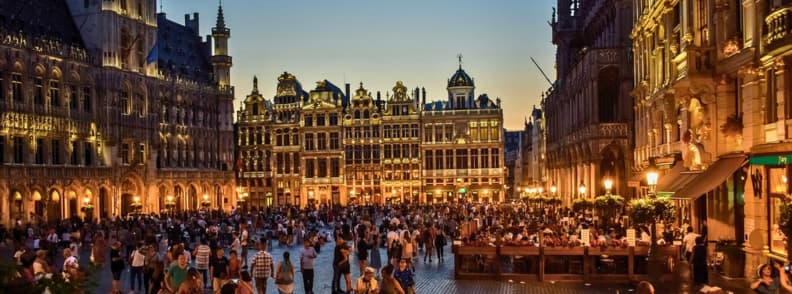
Iconic Districts and Quarters
When you visit Brussels, exploring its diverse districts offers a rich tapestry of experiences. Here’s a concise guide to five iconic neighborhoods:
Marolles District
The Marolles District is a treasure trove for those seeking authentic local culture. At its heart lies the Place du Jeu de Balle, home to a daily flea market bustling with vendors selling antiques, vintage items, and quirky collectibles. This market operates every morning, with over 300 stalls offering a range of objects, furniture, textiles, and accessories. Wandering through the market, you’ll find everything from old photographs to vintage furniture, making it a haven for treasure hunters. The surrounding streets are lined with antique shops and historic brasseries, reflecting the area’s rich history and diverse community.
European Quarter
The European Quarter is the administrative center of the European Union, but it’s also a hub for visitors interested in European politics and culture. The Parlamentarium, Europe’s largest parliamentary visitors’ center, offers interactive exhibits that explain the workings of the European Parliament. Nearby, the House of European History provides insights into the continent’s past. The area is also home to the Parc Léopold, a green space perfect for a leisurely stroll.
Royal Quarter
The Royal Quarter is steeped in history and grandeur. Start at the Royal Palace, the official residence of the Belgian monarchy, and explore the adjacent Parc de Bruxelles, a serene park ideal for a leisurely walk. The Place Royale is surrounded by neoclassical architecture and houses the Magritte Museum, dedicated to the surrealist artist René Magritte.
Heysel & Laeken
In the Heysel and Laeken areas, the Atomium stands as a symbol of Brussels. Built for the 1958 World Fair, this structure offers panoramic views of the city and hosts various exhibitions. Nearby, the Royal Greenhouses of Laeken are open to the public during specific times of the year, showcasing a vast collection of exotic plants. The surrounding parks provide ample green spaces for relaxation.
Saint-Gilles and Ixelles
Art Nouveau enthusiasts will appreciate the architecture in Saint-Gilles and Ixelles. The Horta Museum, once the home of architect Victor Horta, showcases his work and the Art Nouveau style. These districts are also known for their vibrant culinary scenes, with numerous cafes, restaurants, and bars offering a taste of Brussels’ diverse gastronomy. Exploring these districts provides a comprehensive view of Brussels’ rich cultural and historical landscape.
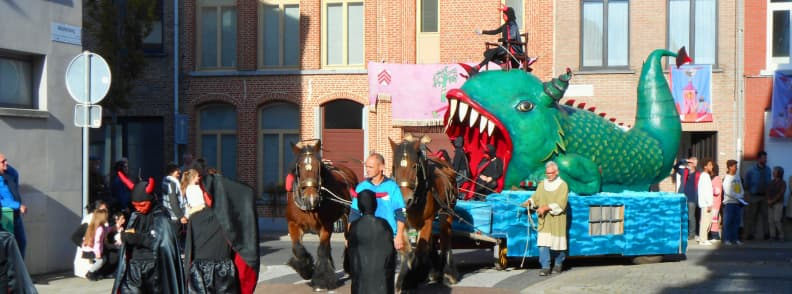
Cultural Heritage and UNESCO Sites
When you visit Brussels, the city’s rich cultural heritage is evident in its stunning Art Nouveau architecture and vibrant traditions. As your Brussels travel guide, I’ll highlight key Art Nouveau buildings and the unique Ommegang parade, both integral to the city’s identity.
Brussels is renowned for its Art Nouveau architecture, a style that emerged in the late 19th century. Architects like Victor Horta and Paul Hankar pioneered this movement, creating structures that harmoniously blend form and function. A prime example is the Hôtel Tassel, designed by Horta in 1893. This building is considered one of the first true Art Nouveau structures, featuring innovative use of materials and open spaces. Its façade and interior showcase the style’s signature whiplash lines and organic motifs.
Another notable site is the Horta Museum, which is housed in Horta’s former residence and studio. The museum offers insight into his design philosophy and the Art Nouveau movement. The Hannon House, designed by Jules Brunfaut, is another gem. After years of closure, it reopened in 2023, allowing visitors to appreciate its exceptional architecture and decoration.
Beyond architecture, Brussels’ cultural heritage includes the Ommegang parade, a tradition dating back to the 14th century. Originally a religious procession, it evolved into a historical reenactment celebrating Emperor Charles V’s 1549 visit to Brussels. Over 1,400 participants don period costumes each year, parading through the city and culminating in a grand spectacle at the Grand Place. Recognized by UNESCO as an Intangible Cultural Heritage, the Ommegang connects the city’s past with its present, offering a unique glimpse into Brussels’ history.
Experiencing Brussels’ Art Nouveau landmarks and the Ommegang parade provides a deep appreciation of the city’s cultural richness. These elements are essential parts of any Brussels tourism guide, offering visitors a chance to connect with the city’s artistic and historical legacy.
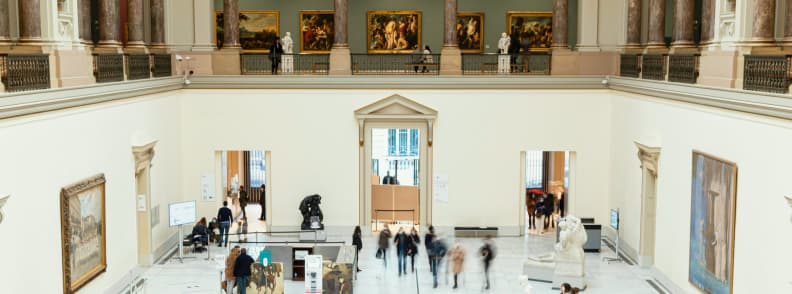
Museums and Art
When you visit Brussels, immersing yourself in its rich art scene is a must. The city boasts a variety of museums that cater to both art enthusiasts and history buffs. Here’s a concise guide to some of the top museums you should consider:
Magritte Museum
Located in the heart of Brussels, the Magritte Museum houses the world’s largest collection of works by the renowned surrealist artist René Magritte. With over 230 pieces, including paintings, drawings, and sculptures, it offers a comprehensive look into Magritte’s creative journey. The museum is situated at Place Royale 1 and is open Tuesday to Sunday from 10:00 to 17:00. Tickets are €10 for adults and €6 for seniors.
Royal Museums of Fine Arts of Belgium
This complex comprises several museums, including the Oldmasters Museum, the Modern Museum, and the Magritte Museum. Art lovers can explore collections ranging from the 15th century to contemporary works. The museums are located at Rue de la Régence 3 and are open Tuesday to Friday from 10:00 to 17:00, and on weekends from 11:00 to 18:00. Admission varies depending on the exhibitions.
Belgian Comic Strip Center
Celebrating Belgium’s rich comic strip heritage, this museum showcases the history and evolution of the “ninth art.” Visitors can enjoy exhibits featuring famous characters like Tintin and the Smurfs. Located at Rue des Sables 20, it’s open daily from 10:00 to 18:00. Tickets are €10 for adults and €8 for seniors.
Art & History Museum
Situated in Cinquantenaire Park, this museum offers extensive collections covering various civilizations and periods. From ancient artifacts to decorative arts, it’s a treasure trove for history enthusiasts. The museum is at Parc du Cinquantenaire 10 and is open Tuesday to Friday from 9:30 to 17:00, and on weekends from 10:00 to 17:00. Admission is €10 for adults and €8 for seniors.
Train World
For a unique experience, Train World offers an immersive journey through the history of Belgian railways. Located at Place Princesse Elisabeth 5, it’s open Tuesday to Sunday from 10:00 to 17:00. Tickets are €12 for adults and €9 for seniors.
When planning your museum visits, consider purchasing the Brussels Card, which provides access to multiple museums and attractions, along with public transport benefits. It’s a cost-effective way to explore the city’s cultural offerings.
Remember to check each museum’s official website for the latest information on opening hours and ticket prices, as these can change. Enjoy your cultural exploration in Brussels!
Where to Stay in Brussels Belgium
When planning your visit to Brussels, the right place to stay can make all the difference, whether you’re on a tight budget or looking for a touch of luxury. Here are my top hotel recommendations across different price ranges to help you navigate the options.
Budget-Friendly Hotels
If you’re traveling on a budget but still want a comfortable place to rest after exploring all the places to visit in Brussels, check out these spots:
- The Scott Hotel Brussels in Saint-Gilles gives you a cozy, modern experience without breaking the bank. The location is perfect for getting around, and the rooms are designed to make your stay pleasant and straightforward. It’s close to local highlights, making it an excellent base for seeing the city’s neighborhoods.
- Hotel De Fierlant, also in the Saint-Gilles area, is a solid choice for budget travelers. This hotel features a comfortable setting with a relaxed lounge area where you can unwind after a long day exploring Brussels’ must-see attractions. It’s a no-fuss, convenient option that feels welcoming.
Mid-Range Comfort
Want a balance between affordability and amenities? These mid-range hotels offer great value and comfort, ideal for those visiting Brussels Belgium for a weekend or a longer city break:
- Harmon House, a stylish boutique hotel opened in 2018, sits in the heart of Saint-Gilles. It features sleek, modern rooms, a spa, and even a rooftop terrace. This place is a perfect blend of comfort and contemporary design, making it great for travelers who like to relax in style after seeing everything on their Brussels city guide.
- Hotel Manos Premier is another fantastic pick, especially if you appreciate a more classic feel. Located near Avenue Louise, it combines old-world charm with modern amenities. The hotel has elegant period furnishings, a lush garden, and a spa with a hammam. It’s ideal for anyone looking to add a touch of luxury to their trip without splurging excessively.
Luxury Stays
If you’re ready to splurge and want to experience the best Brussels has to offer, here are some exceptional hotels that promise a memorable stay:
- Rocco Forte Hotel Amigo is just steps away from the famous Grand Place, making it a prime location for sightseeing. This 5-star hotel is known for its refined, luxurious atmosphere, with designer rooms, a Michelin-starred restaurant, and service that’s hard to beat. Staying here puts you right at the heart of the city, perfect for exploring all the nearby attractions listed in your Brussels tourism guide.
- Steigenberger Icon Wiltcher’s, located on the prestigious Avenue Louise, is the epitome of elegance. The hotel features marble bathrooms, opulent décor, and high-end amenities like fine dining options and a wellness center. If you want your Brussels visit to be an indulgent experience, this hotel is worth every euro.
No matter your budget, Brussels has something to offer for every traveler. From charming and affordable hotels to high-end luxury stays, you’ll find plenty of options that cater to your needs. And as you explore all the best places to visit in Brussels, you can rest assured knowing you have a comfortable spot to return to after a full day of adventures.
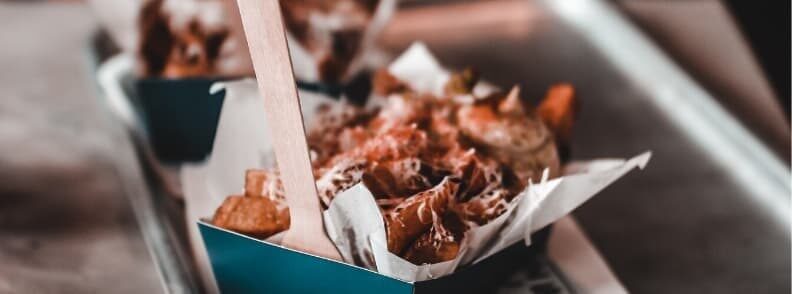
Gastronomy and Culinary Experiences When You Visit Brussels
When you visit Brussels, the city’s culinary scene promises an unforgettable experience that you just can’t skip. From hearty traditional dishes to sweet treats and an impressive beer culture, this Brussels travel guide will walk you through the best places to eat and drink in Belgium’s capital.
Let’s start with some classic Belgian dishes. One of my personal favorites is stoemp, a comforting mash-up of potatoes and vegetables like carrots or leeks, usually served alongside hearty sausages. If you want a truly authentic taste, head over to La Fleur en Papier Doré. It’s a historic café brimming with character, where locals and tourists alike savor the kind of meal that warms you from the inside out. Another classic you should try is vol-au-vent, a puff pastry brimming with a creamy chicken and mushroom filling. This dish, sometimes made even richer with meatballs, is perfect at any of the city’s traditional brasseries.
You also can’t talk about visiting Brussels Belgium without mentioning waffles and chocolate. It’s practically a rite of passage. For a more hands-on experience, why not join a waffle-making workshop? I found these classes fun and genuinely rewarding, and there’s something special about making your own golden, crispy Belgian waffles. And if chocolate is more your thing, you’re in for a treat. Many chocolate-making workshops let you create your very own pralines while teaching you about the art and history behind Belgian chocolate. It’s one of those must-do experiences that are both educational and mouthwateringly delicious.
Now, let’s dive into Brussels’ incredible beer culture. One standout spot is the Cantillon Brewery, a family-run gem that’s been around since 1900. They specialize in lambic beers, and taking a tour there feels like stepping back in time to learn about beer-making traditions that are still upheld today. You’ll get to taste some of their unique brews, which are nothing like the commercial beers you may be used to. If you want to get an even broader taste of Brussels’ beer heritage, consider a beer tour. It’s an adventure that takes you to multiple breweries and bars, giving you a fuller picture of why Belgian beer has such a stellar reputation.
Exploring Brussels’ culinary scene really is a journey into its history and cultural richness. The flavors tell stories, and every dish or drink you try connects you to a deeper sense of place. Trust me, there’s no better way to understand Brussels than by tasting your way through it.
And if you’re wondering where to eat, let me give you a few solid recommendations. Belgium is world-famous for its frites, and for good reason. To taste them at their best, visit Maison Antoine or Frit’Flagey. Both spots are beloved by locals, and their crispy, golden fries are simply unbeatable. If you’re in the mood to sample a variety of street foods, head to Wolf Food Market. It’s a lively place where you can try everything from waffles to international street eats.
For beer lovers, don’t miss the Cantillon Brewery or the modern vibes at Brussels Beer Project. Both places have their own unique take on Belgian brewing traditions. And if you’re into more sustainable dining options, check out Les Filles or Chez Chyl, where eco-conscious meals are prepared with fresh, local ingredients.
Whether you’re a foodie, a beer enthusiast, or just someone who loves trying new things, Brussels is a city that knows how to impress. So go on, eat your way through it. I promise every bite will be worth it.
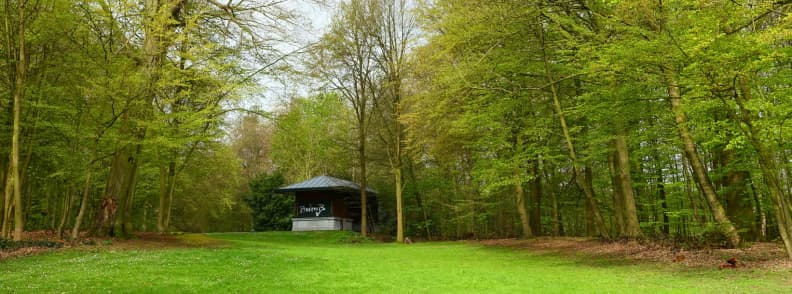
Outdoor Activities and Green Spaces in Brussels
When you visit Brussels, you’ll find a variety of outdoor activities and green spaces that cater to both relaxation seekers and adventure enthusiasts. Here’s a concise guide to some of the city’s top spots:
- Bois de la Cambre. Located in the southern part of Brussels, this expansive park offers a peaceful retreat from the city’s hustle. It’s perfect for leisurely walks, picnics, or rowing on the lake. The park’s vast lawns and wooded areas provide ample space for relaxation.
- Parc du Cinquantenaire. Steeped in history, this park features impressive arches and museums. It’s an ideal spot for a stroll or a jog, with wide avenues and manicured gardens. The park also hosts various events throughout the year.
- Sonian Forest. For those seeking a more immersive nature experience, the Sonian Forest offers extensive trails suitable for hiking and cycling. Covering over 4,000 hectares, it’s a haven for outdoor enthusiasts.
- Parc de Bruxelles (Brussels Park). Situated in the city center, this park is perfect for a quick escape into greenery. With its fountains and statues, it’s a pleasant spot for a midday break.
- Leopold Park. Adjacent to the European Parliament, this park offers a serene environment with a pond and walking paths. It’s a great place to relax after exploring the nearby museums.
Festivals and Events
When you visit Brussels, you’re stepping into a city that knows how to celebrate. From centuries-old traditions to contemporary cultural spectacles, Brussels’ events calendar is packed year-round, and there’s always something exciting happening. Here’s a detailed look at the festivals and events that create an unforgettable atmosphere in the Belgian capital.
Iris Festival
Every May, the Iris Festival marks the anniversary of the Brussels-Capital Region with a citywide celebration that’s anything but ordinary. The streets and parks buzz with free concerts, parades, and unique performances. One of the festival’s highlights is the Parc Royal (Brussels Park) turning into a festive hub filled with family-friendly activities, cultural exhibitions, and food stalls offering the best of Belgian street food, like the famous frites. If you’re into music, the open-air concerts in various city squares will have you tapping your feet. It’s a time when Brussels feels even more alive, so if your visit falls in early May, don’t miss it.
Ommegang
Held in late June or early July, Ommegang is a deep dive into Brussels’ medieval history. This historical pageant dates back to the 16th century and reenacts the 1549 visit of Emperor Charles V to the city. What makes Ommegang special is how it transforms the Grand Place into a stage for an epic show featuring hundreds of actors in authentic costumes, knights on horseback, traditional music, and fireworks. Imagine the square buzzing with the sounds of drums, trumpets, and medieval chants, with every detail meticulously recreated. This isn’t just a performance but an immersion in the past that fills the heart of Brussels with medieval splendor.
Brussels Summer Festival (BSF)
August brings the Brussels Summer Festival (BSF), a ten-day celebration of music that turns the city into a sprawling concert venue. Multiple stages are set up across iconic locations like Mont des Arts and Place des Palais, hosting everything from rock and pop to electronic beats and classical ensembles. BSF attracts a mix of international stars and local talents, so you’ll get a rich variety of sounds. The atmosphere is electric, with food trucks serving up festival eats (think waffles and Frites Atelier Brussel goodies), and crowds dancing from sunset to late night. It’s the perfect way to soak up the energy of Brussels.
Flower Carpet
Every two years in August, the Flower Carpet transforms the Grand Place into a stunning display of floral art. Thousands of begonias are arranged to create a 1,800 square meter masterpiece, each carpet featuring a different theme that celebrates Belgian or world culture. Visitors can admire the breathtaking scene from street level or, for a panoramic view, head up to the balcony of the Town Hall. The intricate designs, combined with the fragrant air, make for an experience that’s as beautiful as it is memorable. This is one of those must-visit events that draws crowds from all over the globe, so plan ahead if you’re visiting Brussels in August.
Winter Wonders
From late November to early January, Brussels embraces the holiday spirit with Winter Wonders, one of the most magical Christmas markets in Europe. Picture this: the Grand Place comes alive with a dazzling light and sound show, while nearby streets are lined with over 200 festive chalets selling artisanal gifts, warm mulled wine, and Belgian chocolate. There’s an ice rink set up for skating, a giant Ferris wheel at Place Sainte-Catherine offering views of the sparkling city, and a cozy, festive atmosphere you won’t want to leave. The whole city transforms into a winter paradise, making it a perfect time to visit with family, friends, or a loved one.
Bright Brussels Festival
One of the newer additions to the city’s event lineup, Bright Brussels illuminates the streets and iconic sites with a series of mesmerizing light installations. Usually held in February, this festival turns dark winter evenings into a colorful spectacle. Walk through places like Parc de Bruxelles and the Quais District, where artists use light to tell stories and create immersive experiences. It’s a captivating event that highlights Brussels’ creative energy.
Brussels Jazz Festival
Jazz lovers should circle January in their calendars for the Brussels Jazz Festival. Hosted at Flagey, one of Brussels’ top cultural venues, this festival brings together international jazz legends and emerging talent for a celebration of smooth, soulful sounds. Each edition explores different themes and styles, from classic swing to experimental jazz, and the intimate setting of Flagey’s studios makes every performance a memorable experience.
For even more events, check the Brussels tourism guide and official events calendar, as the city is full of surprises. Spontaneous art shows, food festivals, and community gatherings can pop up throughout the year, so staying in the loop will help you make the most of your visit. Trust me, Brussels has something for everyone, whether you’re a foodie, a music lover, or a history buff.
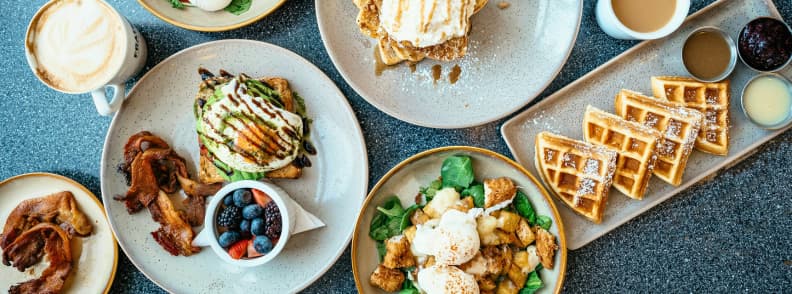
Local Secrets and Off-the-Beaten-Path Tips
When you visit Brussels, it’s easy to get caught up in the well-known attractions. However, the city offers several lesser-known experiences that provide a deeper connection to its culture and history. Here’s a guide to some of these hidden gems:
Explore the Sewer Museum
Located at Porte d’Anderlecht, the Sewer Museum offers a unique perspective on Brussels’ underground infrastructure. The museum provides insights into the city’s sewer system, its history, and the vital role it plays in urban life. Visitors can walk through actual sections of the sewer network, gaining an understanding of the engineering marvels beneath the streets.
Discover Art Nouveau Architecture
Brussels is renowned for its Art Nouveau architecture. Consider joining a guided tour to appreciate the intricate designs of architects like Victor Horta. Notable sites include the Horta Museum and the Cauchie House. These tours often provide access to interiors not typically open to the public, offering a comprehensive view of this architectural style.
Participate in a Gourmet Cooking Class
Engage with Brussels’ culinary scene by taking a cooking class with local chefs. These hands-on sessions teach you how to prepare traditional Belgian dishes, such as mussels with fries or speculoos cookies. It’s an excellent way to learn about local ingredients and cooking techniques, and you get to enjoy the meal you’ve prepared.
Visit Lesser-Known Green Spaces
Beyond the popular parks, Brussels has several tranquil green spaces worth exploring. The Jean Massart Experimental Garden offers a peaceful retreat with a variety of plant species. Similarly, the Rouge-Cloître Abbey’s surrounding woodlands provide scenic walking trails away from the city’s hustle.
Attend Local Workshops
Immerse yourself in Brussels’ artisanal culture by attending workshops in chocolate making or lace crafting. These sessions provide hands-on experience and a deeper appreciation for the city’s traditional crafts.
By incorporating these activities into your itinerary, you’ll experience a side of Brussels that goes beyond the typical tourist path, offering a richer and more personal connection to the city.
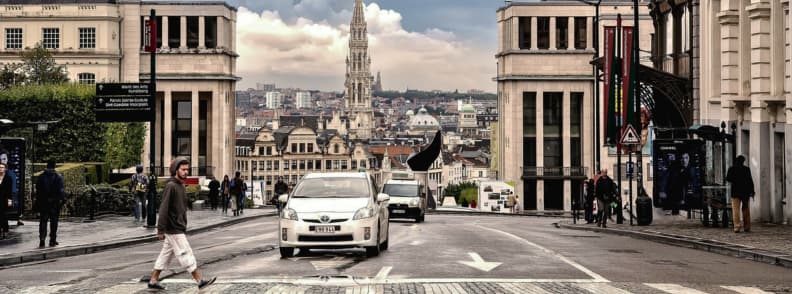
What to Visit in Brussels in 1 Day
If you’re planning to visit Brussels Belgium and have just one day to explore, here’s a concise itinerary to help you experience the city’s highlights efficiently.
Morning
- Grand Place (Grote Markt). Begin your day at Brussels’ central square, renowned for its ornate guild halls and the impressive Town Hall. Arriving early allows you to appreciate the architecture without the usual crowds.
- Manneken Pis. A short walk from the Grand Place leads you to this iconic statue. While modest in size, it’s a significant symbol of the city’s humor and spirit. Nearby, the GardeRobe MannekenPis Museum showcases an extensive collection of the statue’s costumes.
Midday
- Atomium. Consider taking a taxi or using public transport to reach this unique structure, originally built for the 1958 World Expo. The Atomium offers panoramic views of Brussels and houses exhibitions within its spheres. Allocate about an hour for exploration.
- Parc du Cinquantenaire. After visiting the Atomium, head to this expansive park. It’s an ideal spot to relax and, if time permits, visit one of its museums, such as Autoworld or the Art & History Museum.
Lunch
For a taste of local cuisine, try moules-frites at establishments like Le Marmiton or Le Zinneke. These restaurants are known for their quality dishes and authentic atmosphere.
Afternoon
- Cantillon Brewery. Post-lunch, delve into Brussels’ brewing heritage at this family-run brewery. Learn about traditional lambic beer production and enjoy a tasting session.
- Notre Dame du Sablon. This Gothic church is celebrated for its stunning stained-glass windows and serene interior. It’s a peaceful retreat amidst the city’s bustle.
Evening
- Belgian Chocolate. Satisfy your sweet tooth with a visit to renowned chocolatiers like Passion Chocolat or Chocolaterie Mary. Sampling pralines here is a must.
- Palais Royal. Conclude your day with a visit to the Royal Palace. While it’s the official palace of the Belgian monarchy, it’s open to the public during certain periods. Even if closed, the exterior and surrounding gardens are worth viewing.
- Central Brussels. If time allows, wander through the city’s central streets. Areas like the Galeries Royales Saint-Hubert offer a mix of shops, cafes, and architectural beauty.
This itinerary offers a balanced mix of cultural landmarks, culinary experiences, and leisurely exploration, ensuring you make the most of your day in Brussels.
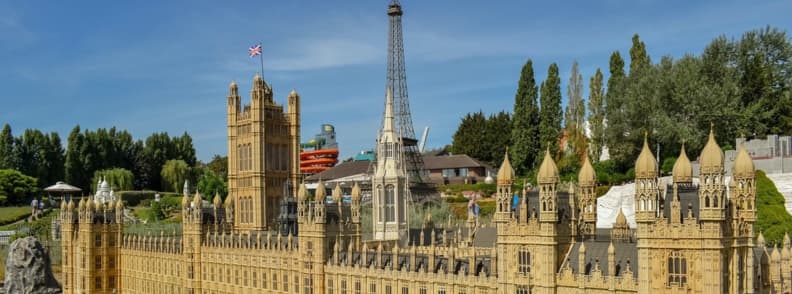
What to Visit in Brussels with Kids
Traveling to Brussels with kids? You’re in for a treat. This city isn’t just about stunning architecture and fine chocolates; it’s packed with attractions that will fascinate little ones and make your family adventure memorable. From miniature wonders to prehistoric creatures, here’s your ultimate Brussels city guide for family fun.
Mini-Europe: A Trip Across the Continent in One Afternoon
If you’re wondering what to visit in Brussels that’s both educational and entertaining, Mini-Europe should top your list. This fascinating park is located at the foot of the Atomium, and it’s a hit with both kids and adults. Picture walking through a miniature version of Europe, where your children can see the Eiffel Tower, the Leaning Tower of Pisa, and even the eruption of Mount Vesuvius — all in one place.
The intricate details of the 350 models are astonishing, and the interactive features make learning about Europe’s landmarks a blast. It’s a great way to add some cultural education to your trip without feeling like a boring history lesson. If you’re visiting during warmer months, plan a couple of hours here and don’t miss the impressive light and sound show in the evenings.
Museum of Natural Sciences: Dinosaur Heaven
Next on the list is the Museum of Natural Sciences, a spot that’s sure to excite any young dino enthusiast. This isn’t just any museum; it houses Europe’s largest dinosaur gallery, featuring towering skeletons of iguanodons discovered in a coal mine in Belgium. Walking through the exhibit, your kids will come face-to-face with these prehistoric giants and can even participate in hands-on activities like fossil excavation and learning labs. It’s an engaging experience that keeps kids’ energy levels high and their curiosity even higher. Plus, if you’re looking for places to visit in Brussels where everyone can learn something new, this museum is a no-brainer.
Bois de la Cambre: A Green Escape in the Heart of the City
Sometimes, kids just need a break from museums and sightseeing, and Bois de la Cambre is the perfect spot to let them run free. This sprawling urban park is a lush, green haven ideal for a picnic or a leisurely afternoon. Pack a lunch, rent a rowboat on the serene lake, or let your kids have a blast on one of the playgrounds. There’s even a charming little island in the middle of the lake with a café, where parents can take a moment to relax while keeping an eye on the children. It’s a great way to unwind, especially if you’re juggling an action-packed itinerary. Just remember to bring a ball or frisbee for some family-friendly fun.
Atomium: A Futuristic Adventure
The Atomium isn’t just an architectural icon; it’s a full-on experience that will leave your kids wide-eyed. Built for the 1958 World Expo, this gigantic structure replicates an iron crystal magnified 165 billion times. Take the futuristic escalators up to the top sphere for unbeatable panoramic views of Brussels. The elevator ride itself is a thrill, and once you’re at the top, you’ll be rewarded with breathtaking sights over the city. The spheres house various exhibitions that are visually stimulating and designed to spark curiosity, perfect for inquisitive young minds. Make sure to check if there are any temporary exhibits during your visit, as these often include kid-friendly themes and activities.
These are just a few family-friendly gems in Brussels, but there’s plenty more to explore. If you’re looking for more ideas on where to visit in Brussels, consider adding stops like the Belgium Comic Strip Center or even some classic Brussels frites at Frites Atelier Bruxelles.
Don’t forget to grab your Brussels Card for discounts on multiple attractions. A little planning goes a long way to make your visit to Brussels Belgium both smooth and memorable for everyone.
Practical Travel Information
Knowing how to navigate the city when you visit Brussels can transform your experience from just another vacation to a smooth, memorable adventure. Whether you’re breezing through the Brussels tourism guide for the first time or coming back to explore more hidden corners, getting around efficiently is key. This Brussels visitor guide breaks down the essentials so you’re equipped to explore with ease.
Getting Around Brussels
Public transport in Brussels is one of the best ways to explore the city. The network, managed by STIB/MIVB, includes a mix of buses, trams, and metro lines that connect every corner of the city. Services run from 5 a.m. to midnight, making it easy to get to all the places to visit in Brussels without breaking a sweat. If you’re planning on some late-night fun, the Noctis night buses have you covered on weekends until 3 a.m. Keep in mind that while public transport is convenient, the occasional strike might disrupt services—something to keep an eye on.
For those who want to maximize savings, consider picking up a Brussels Card. It not only grants unlimited travel on public transport but also unlocks access to a range of museums. If you’re a museum buff or plan on zipping around town, it’s well worth it. Remember, most transport options are accessible with contactless cards and apps, so you don’t need to fuss over cash.
Low Emission Zone (LEZ)
Now, if you’re thinking about driving around Brussels, let’s talk about the Low Emission Zone (LEZ). Brussels takes air quality seriously, and LEZ regulations mean that high-emission vehicles — whether you’re driving a van, a bus, or just your everyday car — may be restricted. This rule applies to vehicles from all countries, not just Belgium. Before driving into the city, check your vehicle’s compliance online to avoid fines that could sour your Brussels visit. Honestly, with parking often scarce and traffic adding to the stress, sticking to public transport or even renting a bike might be your best bet.
Arriving in Brussels
Getting to Brussels is straightforward. If you’re flying in, you’ll likely land at Brussels Airport, located just 20 kilometers from the city center. The train from the airport to the central station is quick and efficient. Alternatively, you can hop on a bus or grab a taxi, but traffic can be unpredictable. For those arriving by train, Brussels has connections across Europe, and the Eurostar and Thalys services bring you straight to Gare du Midi.
If you’re traveling on a budget, buses from major European cities are an option, though they take longer and tend to drop you outside the city center. Make sure to research your arrival options in advance so you don’t waste time or money when you get here.
Tourist Information Offices
For maps, guidance, or if you just have a question, stop by one of the tourist information offices scattered around the city. The most central one is at the Grand Place. They’re incredibly helpful, and it’s a good spot to grab free resources or chat about the day’s events.
Etiquette and Cultural Norms
When you visit Brussels, understanding local etiquette, especially in food markets, enhances your experience. Here’s a concise guide to help you navigate these cultural norms:
- Greet vendors. In Brussels, a simple Bonjour (French) or Goedemorgen (Dutch) when approaching a stall is customary. This small gesture shows respect and opens the door to friendly interactions.
- Handle produce with care. Unlike some markets where touching produce is common, in Brussels, it’s polite to ask before handling items. Vendors often prefer to select and bag produce for you. A quick Puis-je toucher? (French) or Mag ik dit aanraken? (Dutch) is appreciated.
- Queue patiently. Brussels markets can be bustling, especially on weekends. Forming an orderly line and waiting your turn is expected. Jumping ahead or crowding the stall is considered rude.
- Cash is king. While card payments are becoming more common, many market vendors still prefer cash. Carrying small bills and coins facilitates smoother transactions.
- Sampling etiquette. Vendors may offer samples, but it’s courteous to ask before trying. If you sample, consider purchasing as a sign of appreciation.
- Bargaining practices. Haggling isn’t typical in Brussels food markets. Prices are usually fixed, and attempting to negotiate can be seen as disrespectful.
- Environmental considerations. Brussels places a strong emphasis on sustainability. Bringing your own reusable bags is not only practical but also aligns with local environmental values.
- Language awareness. Brussels is bilingual, with French and Dutch as official languages. While many vendors speak English, using basic French or Dutch phrases shows respect and can lead to more positive interactions.
- Enjoying street food. When indulging in street food, like the famous Belgian frites, it’s common to eat while standing or walking. Dispose of any waste in the provided bins to keep the city clean.
By observing these simple customs, your visit to Brussels’ markets will be more enjoyable and respectful.
Travel Guide Brussels Tips
- Avoid driving unless necessary. Even if your car meets LEZ standards, navigating Brussels’ narrow streets can be frustrating. Parking is another hassle, with limited spaces and high fees.
- When using public transport, validate your ticket at the machines on trams and buses. Spot checks are frequent, and fines aren’t worth the risk.
- If you’re visiting popular attractions, like the Atomium or the Royal Museums of Fine Arts, aim for early mornings or late afternoons to skip the crowds.
- Don’t miss out on a food tour that includes Frites Atelier Bruxelles for some of the best Belgian fries around.
From bustling trams to scenic cycling paths, Brussels has options to suit every traveler. With this practical Brussels tourist guide, you’ll be exploring like a pro, making the most of your time in this city that’s a true crossroad of cultures. Ready to get out there? Grab your Brussels city guide and get going!
Visit Brussels Card
When planning your trip to Brussels, consider the Brussels Card — a practical tool that enhances your experience and offers significant savings. This card provides free access to 49 museums and attractions, along with discounts at various restaurants and shops. It’s available in 24-, 48-, or 72-hour options, allowing you to choose the duration that best fits your itinerary.
One of the standout features of the Brussels Card is its inclusion of unlimited access to the city’s public transportation system. This means you can hop on buses, trams, and metros without worrying about individual ticket purchases, making it easier to explore different neighborhoods and attractions.
For art and history enthusiasts, the card grants entry to renowned institutions such as the Magritte Museum, the Royal Museums of Fine Arts, and the Belgian Comic Strip Center. Food lovers can enjoy discounts at various eateries, including the famous Frites Atelier Bruxelles, known for its gourmet Belgian fries.
Purchasing the Brussels Card is straightforward. You can buy it online before your trip or at designated sales points throughout the city, such as the visit.brussels offices located at the Town Hall on Grand Place and on Rue Royale. Once activated, the card is valid for the consecutive hours corresponding to your chosen duration.
In summary, the Brussels Card is a valuable investment for visitors aiming to maximize their time and budget while exploring the city’s rich cultural offerings. It simplifies access to major attractions and provides the convenience of unlimited public transport, making your Brussels visit more enjoyable and efficient.
FAQs about Visiting Brussels
Planning a trip to Brussels? Here are some frequently asked questions to help you make the most of your visit.
When is the best time to visit Brussels Belgium?
Brussels is delightful year-round, but each season offers a unique experience. Spring (March to May) brings mild temperatures and blooming parks, making it ideal for outdoor activities. Summer (June to August) is vibrant with festivals and events, though it’s also the peak tourist season. Autumn (September to November) offers a cozy atmosphere with fewer crowds and beautiful foliage. Winter (December to February) is colder but features charming Christmas markets and festive decorations.
How do I get around in Brussels Belgium?
Brussels boasts an efficient public transport system operated by STIB/MIVB, including buses, trams, and metros. The metro operates from 5:30 am to midnight on weekdays and from 6 am to 12:30 am on weekends and public holidays. Tickets can be purchased at stations or via contactless payment methods. For a more active experience, consider renting a bike; the city is bike-friendly with numerous cycling paths. Walking is also a great way to explore the compact city center.
Do I need to speak French or Flemish when I visit Brussels?
While French and Flemish (Dutch) are the official languages, English is widely spoken, especially in tourist areas. Learning a few basic phrases in French or Flemish can enhance your experience and is appreciated by locals.
Why trust The Travel Bunny for Brussels travel tips?
At The Travel Bunny, we share personal experiences and insider tips to help you explore Brussels like a local. From hidden gems to practical advice, the goal is to provide actionable information to make your trip unforgettable.
Your Brussels Adventure Awaits
Visiting Brussels offers a rich tapestry of experiences, from its historic Grand Place to the quirky Manneken Pis. This Brussels travel guide has highlighted the city’s must-see attractions, culinary delights, and vibrant neighborhoods. Whether you’re planning a short trip or an extended stay, Brussels has something for every traveler.
As you plan your visit, consider the Brussels Card for access to numerous museums and attractions. Don’t miss out on local favorites like Frites Atelier Brussel for authentic Belgian fries. Exploring the city’s diverse districts will provide a deeper understanding of its unique character.
Remember, the best way to experience Brussels is to immerse yourself in its culture, savor its cuisine, and engage with its history. Safe travels, and enjoy every moment in this captivating city.

I’m Olivia Peeters, a sustainable travel expert from Belgium with a deep passion for exploring the great outdoors. As a native of Flanders, I’ve spent years discovering the region’s hidden gems, often by hiking, cycling, or sailing through its scenic landscapes. My love for adventure and eco-conscious travel has given me a unique perspective on what makes Belgium — and especially Brussels — a captivating place to visit.
Brussels stands as the political heart of Europe, where history, culture, and sustainability intersect. Drawing from my local insights and firsthand experiences, I aim to offer practical advice and a Brussels tourist guide that will help you see the city through an eco-friendly lens. Whether you’re visiting for the food, the landmarks, or the outdoor activities, I’m here to guide you through the best ways to experience Brussels responsibly and memorably.
You too can become a guest blogger on The Travel Bunny. Just submit a free guest post.
After this visit Brussels travel guide, here are some other travel blog articles you should read on The Travel Bunny
Best 3 things to do in Belgium
Visit Antwerp: A brief travel guide
Visit Ghent, Belgium: Quick travel guide

